- Books Name
- Mathmatics Book Based on NCERT
- Publication
- KRISHNA PUBLICATIONS
- Course
- CBSE Class 12
- Subject
- Mathmatics
Angle Between Two lines
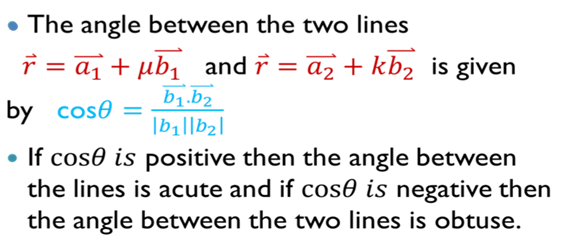
Cartesian Form:

be two lines then angle between two lines is

Note:- If a₁,b₁,c₁, and a₂,b₂,c₂, are the direction ratios of two lines then
i) the lines are parallel if ![]()
ii) the lines are perpendicular if ![]()
Skew lines: Skew lines are lines in space which are neither parallel nor
intersecting. They lie in different planes.
Angle between two skew lines: Angle between skew lines is the angle between
two intersecting lines drawn from any point (preferably through the origin)
parallel to each of the skew lines.
Example: Find the angle between the pair of lines given by:
(x + 3)/3 = (y – 1)/5 = (z + 3)/4 and (x + 1)/1 = (y – 4)/1 = (z – 5)/2
Answer: We can solve this problem by finding the cosine of the angle between the two lines and then taking an inverse of the cosine. Let q be the angle between the two lines. We know from the formula that:
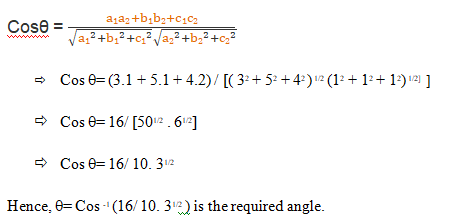
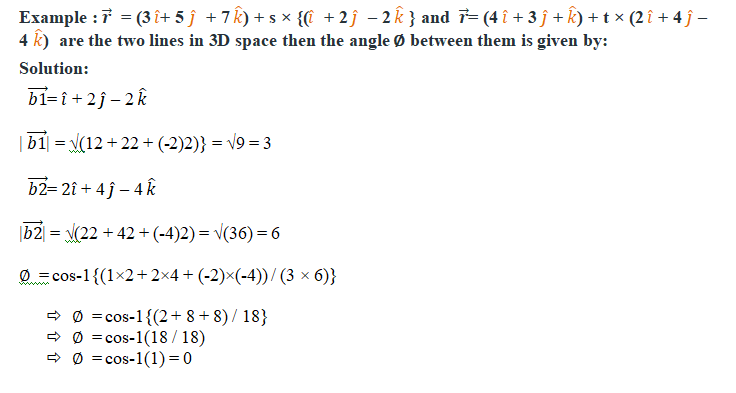

Coplanarity of Two Lines:
Coplanar lines are the lines that lie on the same plane. Prove that two lines are coplanar using the condition in vector form and Cartesian form.
Condition for Coplanarity in Vector Form
In vector form, let us consider the equations of two straight lines to be as under:

What do these equations mean? It means that the first line passes through a point, say L, whose position vector is given by ![]() and is parallel to
and is parallel to ![]() . Similarly, the second line is said to pass through another point whose position vector is given by
. Similarly, the second line is said to pass through another point whose position vector is given by ![]() and is parallel to
and is parallel to ![]()
The condition for coplanarity is that the line joining the two points must be perpendicular to the product of the two vectors, m1 and m2. To illustrate this, we know that the line joining the two said points can be written in vector form as ![]() . So, we have:
. So, we have:
![]()
Condition for Coplanarity in Cartesian Form
The derivation of the condition for coplanarity in Cartesian form stems from the vector form. Let us consider two points L (x1, y1, z1) & M (x2, y2, z2) in the Cartesian plane. Let there be two vectors ![]() and
and ![]() . Their direction ratios are given by a1, b1, c1 and a2, b2, c2 respectively.
. Their direction ratios are given by a1, b1, c1 and a2, b2, c2 respectively.
The vector equation of the line joining L and M can be given as:
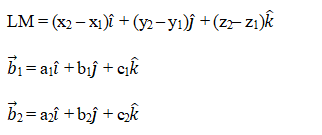
Now use the above condition in vector form to derive our condition in Cartesian form.
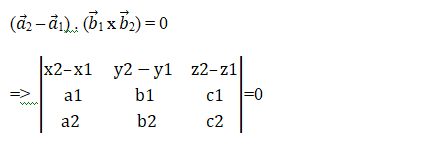
Question : Are the lines (x + 3)/3 = (y – 1)/1 = (z – 5)/5 and (x + 1)/ -1 = (y – 2)/2 = (z – 5)/5 coplanar?
Answer: Comparing the equations with the general form, we have:
(x1, y1, z1) = (-3, 1, 5) and (x2, y2, z2) = (-1, 2, 5).
Note that a1, b1, c1 = -3, 1, 5 and a2, b2, c2 = -1, 2, 5.
So, by Cartesian form, we must solve the matrix:
= 2(5 – 10) – 1(-15 + 5) + 0(-6 + 1) = -10 + 10 = 0
Since the solution of the matrix gives us 0, we can say that the given lines are coplanar
This can be used as is for calculation purposes. By the condition above, the two lines would be coplanar if LM. (m1 x m2) = 0. Therefore, in Cartesian form, the matrix representing this equation is given as 0.

 KRISHNA PUBLICATIONS
KRISHNA PUBLICATIONS
